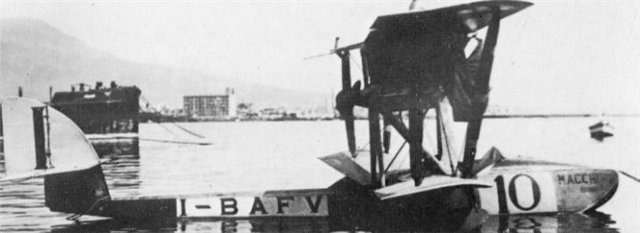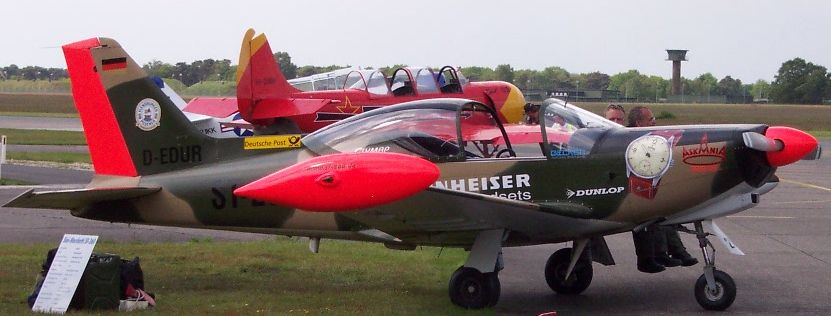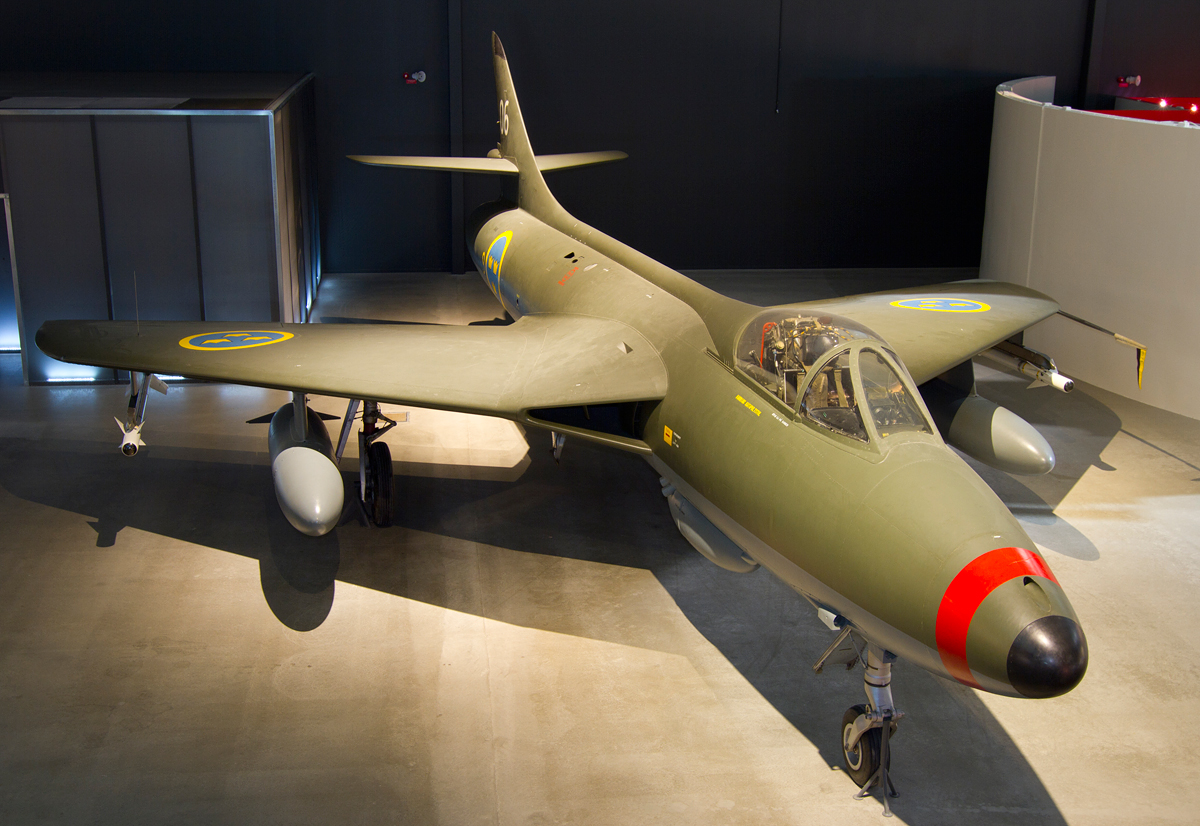|
Macchi M.7
The Macchi M.7 was an Italian single-seat fighter flying boat designed by Alessandro Tonini and built by Macchi. A modified version of the M.7, the M.7bis won the Schneider Trophy in 1921. Development The M.7 was similar to the earlier M.5 but had a modified hull and was powered by an Isotta Fraschini V.6 engine. Due to the end of World War I, only 17 aircraft were delivered to the Italian Navy. In 1919, two were sold to Argentina and four to Sweden, and in 1921, Brazil bought three. In 1920, Tonini designed the M.7bis a racing version of the M.7 for the Schneider Trophy. The M.7bis had a lighter structure and reduced-span wings. Five M.7s entered the 1921 competition at Venice, which was won by Giovanni di Briganti flying the M.7bis. At the 1922 competition at Naples, the M.7bis came in fourth. In 1923, a revised variant of the M.7, the M.7ter appeared. This had a redesigned hull, revised wing configuration and a new tail unit. Three different versions of the M.7ter wer ... [...More Info...] [...Related Items...] OR: [Wikipedia] [Google] [Baidu] |
WikiProject Aircraft
A WikiProject, or Wikiproject, is a Wikimedia movement affinity group for contributors with shared goals. WikiProjects are prevalent within the largest wiki, Wikipedia, and exist to varying degrees within Wikimedia project, sister projects such as Wiktionary, Wikiquote, Wikidata, and Wikisource. They also exist in different languages, and translation of articles is a form of their collaboration. During the COVID-19 pandemic, CBS News noted the role of Wikipedia's WikiProject Medicine in maintaining the accuracy of articles related to the disease. Another WikiProject that has drawn attention is WikiProject Women Scientists, which was profiled by ''Smithsonian Magazine, Smithsonian'' for its efforts to improve coverage of women scientists which the profile noted had "helped increase the number of female scientists on Wikipedia from around 1,600 to over 5,000". On Wikipedia Some Wikipedia WikiProjects are substantial enough to engage in cooperative activities with outside organization ... [...More Info...] [...Related Items...] OR: [Wikipedia] [Google] [Baidu] |
Regia Marina
The ''Regia Marina'' (; ) was the navy of the Kingdom of Italy (''Regno d'Italia'') from 1861 to 1946. In 1946, with the birth of the Italian Republic (''Repubblica Italiana''), the ''Regia Marina'' changed its name to ''Marina Militare'' ("Military Navy"). Origins The ''Regia Marina'' was established on 17 March 1861 following the proclamation of the formation of the Kingdom of Italy. Just as the Kingdom was a unification of various states in the Italian peninsula, so the ''Regia Marina'' was formed from the navies of those states, though the main constituents were the navies of the former kingdoms of Sardinia and Naples. The new Navy inherited a substantial number of ships, both sail- and steam-powered, and the long naval traditions of its constituents, especially those of Sardinia and Naples, but also suffered from some major handicaps. Firstly, it suffered from a lack of uniformity and cohesion; the ''Regia Marina'' was a heterogeneous mix of equipment, standards and p ... [...More Info...] [...Related Items...] OR: [Wikipedia] [Google] [Baidu] |
Biplanes
A biplane is a fixed-wing aircraft with two main wings stacked one above the other. The first powered, controlled aeroplane to fly, the Wright Flyer, used a biplane wing arrangement, as did many aircraft in the early years of aviation. While a biplane wing structure has a structural advantage over a monoplane, it produces more drag than a monoplane wing. Improved structural techniques, better materials and higher speeds made the biplane configuration obsolete for most purposes by the late 1930s. Biplanes offer several advantages over conventional cantilever monoplane designs: they permit lighter wing structures, low wing loading and smaller span for a given wing area. However, interference between the airflow over each wing increases drag substantially, and biplanes generally need extensive bracing, which causes additional drag. Biplanes are distinguished from tandem wing arrangements, where the wings are placed forward and aft, instead of above and below. The term is als ... [...More Info...] [...Related Items...] OR: [Wikipedia] [Google] [Baidu] |
Macchi Aircraft
Aermacchi was an Italian aircraft manufacturer. Formerly known as Aeronautica Macchi, the company was founded in 1912 by Giulio Macchi at Varese in north-western Lombardy as Nieuport-Macchi, to build Nieuport monoplanes under licence for the Italian military. With a factory located on the shores of Lake Varese, the firm originally manufactured a series of Nieuport designs, as well as seaplanes. After World War II, the company began producing motorcycles as a way to fill the post-war need for cheap, efficient transportation. The company later specialised in civil and military pilot training aircraft. In July 2003, Aermacchi was integrated into the Finmeccanica Group (now Leonardo) as Alenia Aermacchi, which increased its shareholding to 99%. Military trainers Since the beginning, the design and production of military trainers have been the core business of Alenia Aermacchi. The products include: * SF-260, piston-engined or turboprop-powered screener/primary trainer * M ... [...More Info...] [...Related Items...] OR: [Wikipedia] [Google] [Baidu] |
Flying Boats
A flying boat is a type of fixed-winged seaplane with a hull, allowing it to land on water. It differs from a floatplane in that a flying boat's fuselage is purpose-designed for floatation and contains a hull, while floatplanes rely on fuselage-mounted floats for buoyancy. Though the fuselage provides buoyancy, flying boats may also utilize under-wing floats or wing-like projections (called sponsons) extending from the fuselage for additional stability. Flying boats often lack landing gear which would allow them to land on the ground, though many modern designs are convertible amphibious aircraft which may switch between landing gear and flotation mode for water or ground takeoff and landing. Ascending into common use during the First World War, flying boats rapidly grew in both scale and capability during the interwar period, during which time numerous operators found commercial success with the type. Flying boats were some of the largest aircraft of the first half of th ... [...More Info...] [...Related Items...] OR: [Wikipedia] [Google] [Baidu] |
1910s Italian Fighter Aircraft
Year 191 ( CXCI) was a common year starting on Friday (link will display the full calendar) of the Julian calendar. At the time, it was known as the Year of the Consulship of Apronianus and Bradua (or, less frequently, year 944 ''Ab urbe condita''). The denomination 191 for this year has been used since the early medieval period, when the Anno Domini calendar era became the prevalent method in Europe for naming years. Events By place Parthia * King Vologases IV of Parthia dies after a 44-year reign, and is succeeded by his son Vologases V. China * A coalition of Chinese warlords from the east of Hangu Pass launches a punitive campaign against the warlord Dong Zhuo, who seized control of the central government in 189, and held the figurehead Emperor Xian hostage. After suffering some defeats against the coalition forces, Dong Zhuo forcefully relocates the imperial capital from Luoyang to Chang'an. Before leaving, Dong Zhuo orders his troops to loot the tombs of the ... [...More Info...] [...Related Items...] OR: [Wikipedia] [Google] [Baidu] |
List Of Military Aircraft Of Sweden
This is a list of Swedish military aircraft since its start. It is not guaranteed to be up-to-date or to be accurate, or complete. Aircraft still in service noted. Early aircraft Early balloons of the Army and Navy Early Navy (The aviation corps became a separate organization in 1915.) Early Army (The aviation corps became a separate organization in 1915.) Air Force (1926–40) Created in July of 1926. Later XX implies later redesignation. Fighters (''Jakt'') Bombers (''Bomb''), torpedo bombers (''Torped'') and ground attack (''Attack'') Reconnaissance (''Spaning'') Transport (''Transport'') Trainers (''Skol'') and advanced trainers (''Övning'') Experimental/prototype/projects (''Prov'') Undesignated/Miscellaneous Not used by air force Gliders * G = ''Glidflygplan'' "glider" * Se = ''Segelflygplan'', "soarer" (sailplane), * Lg = ''Lastglidare'', "transport glider" Post-1940 designation system (Aircraft still in service have a light green background.) ... [...More Info...] [...Related Items...] OR: [Wikipedia] [Google] [Baidu] |
List Of Seaplanes And Flying Boats
The following is a list of seaplanes, which includes floatplanes and flying boats. A seaplane is any airplane that has the capability of landing and taking off from water, while an amphibian is a seaplane which can also operate from land. (They do not include rotorcraft, or ground-effect vehicles which can only skim along close to the water) A flying boat relies on its main hull for buoyancy, while a floatplane has a conventional aircraft fuselage fitted with external floats. In some locales, the term "seaplane" is used as a synonym for floatplane. List A small number of seaplanes have retractable beaching gear, which is not capable of being used for landings and takeoffs, but these remain flying boats or floatplanes and are not amphibians. Many floatplanes, especially those since 1945, can have either conventional floats for operating just from water, or amphibious floats, which have retractable undercarriage built into them. Some experimental flying boats have used skis or ... [...More Info...] [...Related Items...] OR: [Wikipedia] [Google] [Baidu] |
Vickers Machine Gun
The Vickers machine gun or Vickers gun is a water-cooled .303 British (7.7 mm) machine gun produced by Vickers Limited, originally for the British Army. The gun was operated by a three-man crew but typically required more men to move and operate it: one fired, one fed the ammunition, the others helped to carry the weapon, its ammunition, and spare parts. It was in service from before the First World War until the 1960s, with air-cooled versions of it on many Allied World War I fighter aircraft. The weapon had a reputation for great solidity and reliability. Ian V. Hogg, in ''Weapons & War Machines'', describes an action that took place in August 1916, during which the British 100th Company of the Machine Gun Corps fired their ten Vickers guns to deliver sustained fire for twelve hours. Using 100 barrels, they fired a million rounds without breakdowns. "It was this absolute foolproof reliability which endeared the Vickers to every British soldier who ever fired one. It nev ... [...More Info...] [...Related Items...] OR: [Wikipedia] [Google] [Baidu] |
Fvm Macchi M7 (German: ')
{{disambiguation ...
FVM may refer to: * Finite volume method * Five Mile Airport, in Alaska, United States * Flugfélag Vestmannaeyja, a defunct Icelandic airline * Fuvahmulah Airport, in Maldives * Middle Rhine Football Association The Middle Rhine Football Association (german: Fußball-Verband Mittelrhein, FVM) is the umbrella organization of the football clubs in the German mid-Rhein area and covers the football districts of Aachen, Berg, Bonn, Düren, Euskirchen, Heinsbe ... [...More Info...] [...Related Items...] OR: [Wikipedia] [Google] [Baidu] |
Swedish Air Force Museum
The Swedish Air Force Museum ( sv, Flygvapenmuseum) is located at Malmen Airbase in Malmslätt, just outside Linköping, Sweden. Malmen is where Baron Carl Cederström, nicknamed the "Flyer Baron" founded his flying school in 1912. Malmen Airbase is home to the Royal Swedish Airschool operating SAAB 105 (SK60) jet trainers. Along with the Swedish Army Museum (Armémuseum) in Stockholm, Flygvapenmusem constitutes the government agency ''Statens försvarshistoriska museer'' ("Swedish Museums of the Defence Forces"). History The museum’s collection of artifacts includes aircraft, engines, instruments and uniforms. The museum has a knowledge centre (faktarum), with library and archives, containing literature, periodicals, plans, photographs and personal files relating to aviation. The museum is part of the National Swedish Museums of Military History, a government agency. The establishment of the Swedish Air Force Museum was also aided by the Östergötland Society for Aviation Hi ... [...More Info...] [...Related Items...] OR: [Wikipedia] [Google] [Baidu] |
Swedish Air Force
The Swedish Air Force ( sv, Svenska flygvapnet or just ) is the air force branch of the Swedish Armed Forces. History The Swedish Air Force was created on 1 July, 1926 when the aircraft units of the Army and Navy were merged. Because of the escalating international tension during the 1930s the Air Force was reorganized and expanded from four to seven squadrons. World War II When World War II broke out in 1939 further expansion was initiated and this substantial expansion was not finished until the end of the war. Although Sweden never entered the war, a large air force was considered necessary to ward off the threat of invasion and to resist pressure through military threats from the great powers. By 1945 the Swedish Air Force had over 800 combat-ready aircraft, including 15 fighter divisions. A major problem for the Swedish Air Force during World War II was the lack of fuel. Sweden was surrounded by countries at war and could not rely on imported oil. Instead domestic oi ... [...More Info...] [...Related Items...] OR: [Wikipedia] [Google] [Baidu] |

.jpg)



.jpg)
